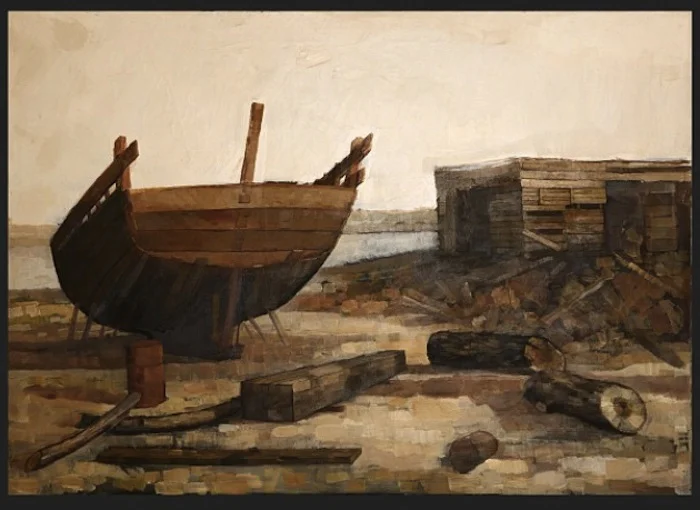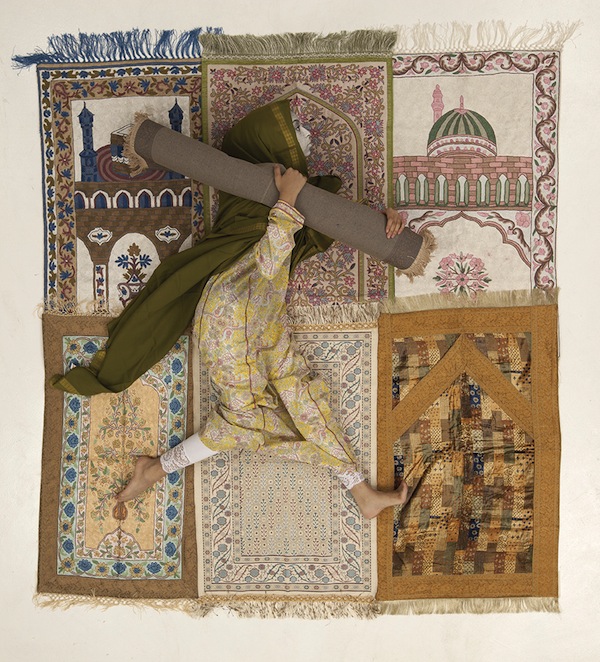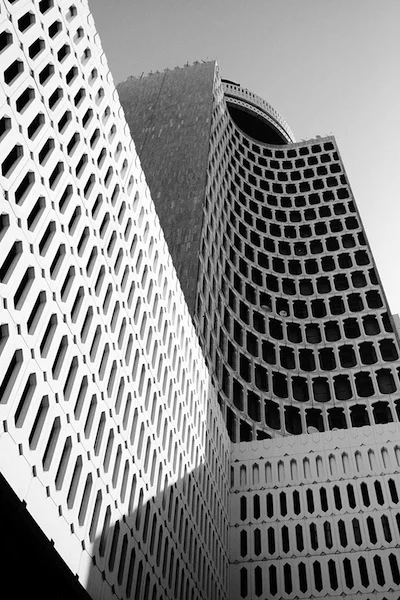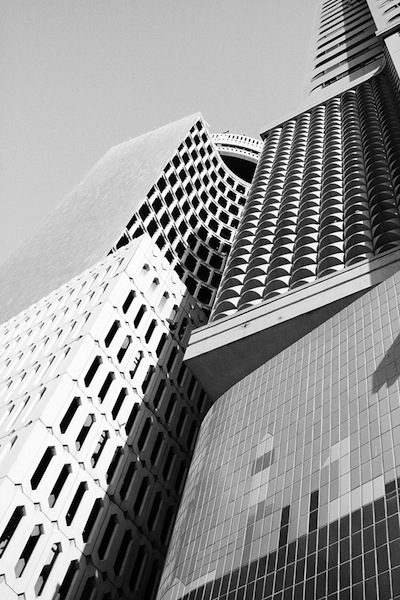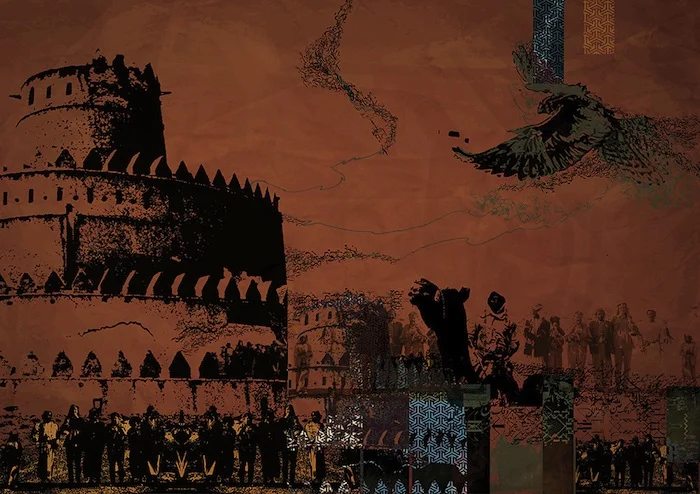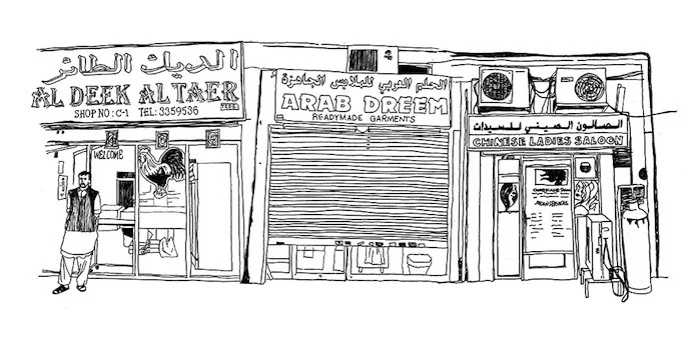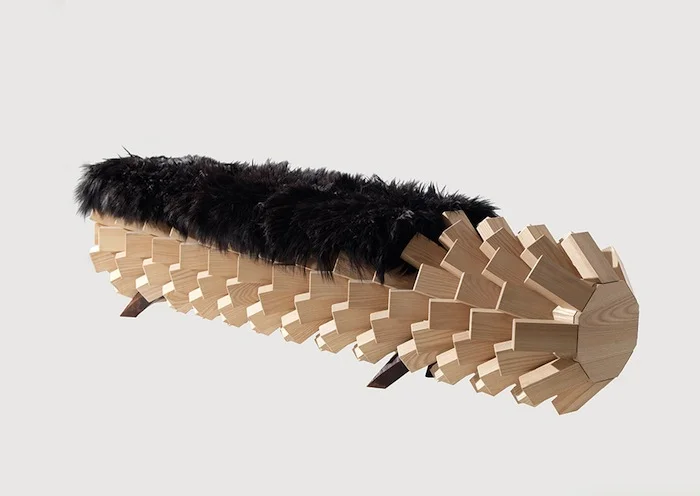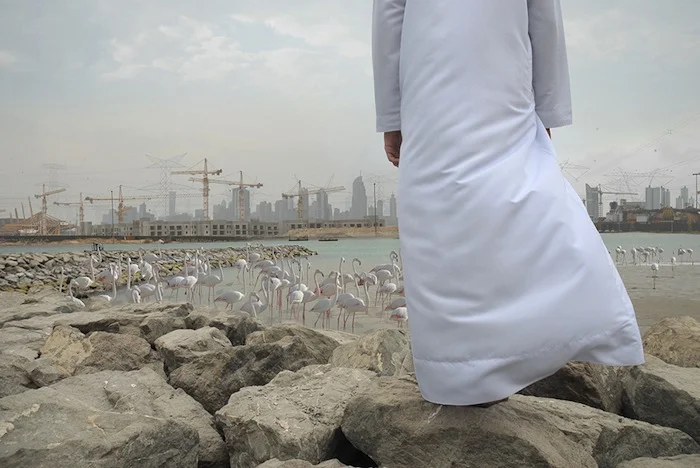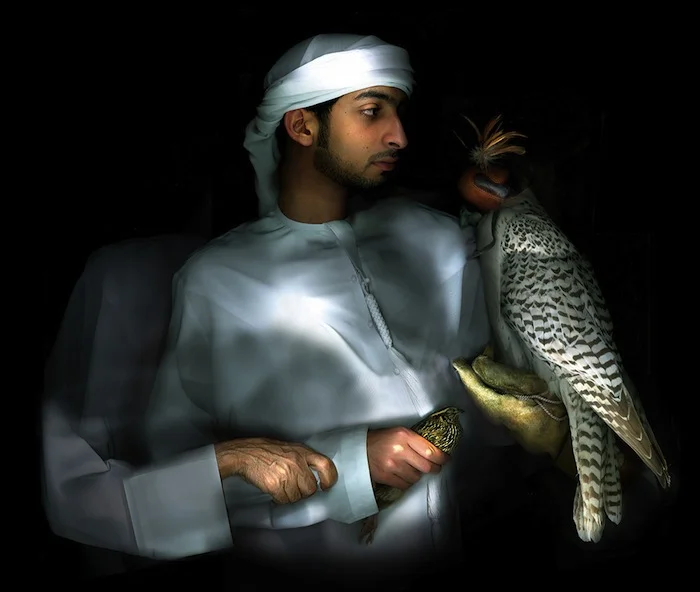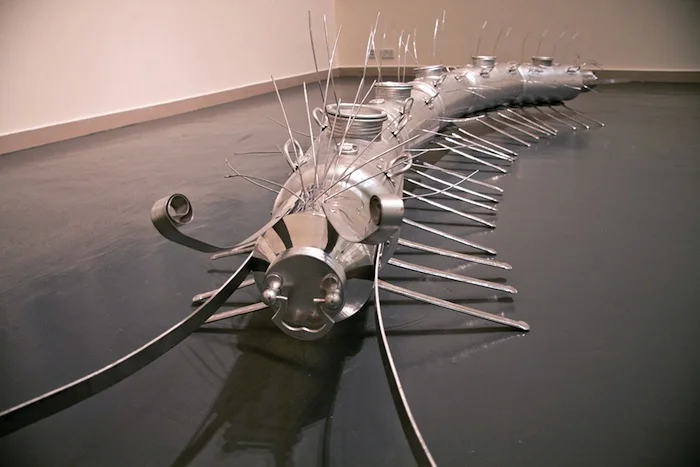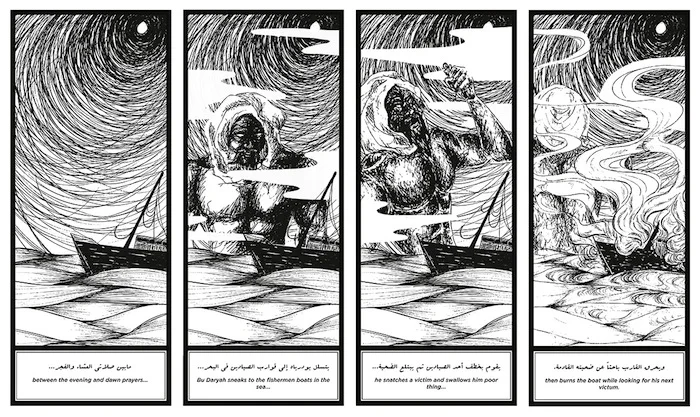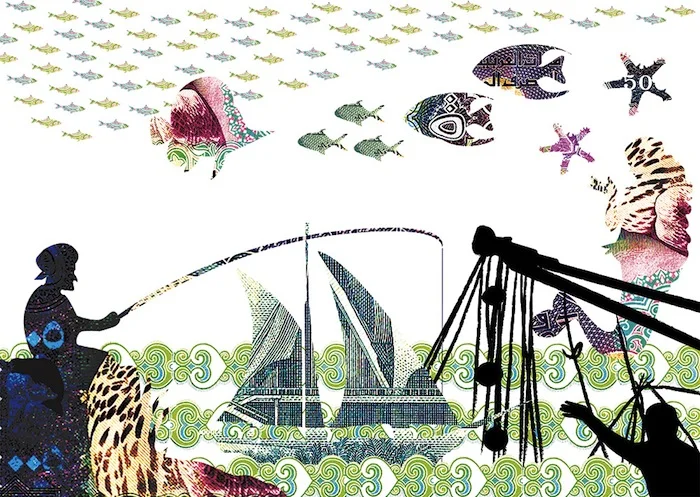Past Forward: Contemporary Art from the Emirates
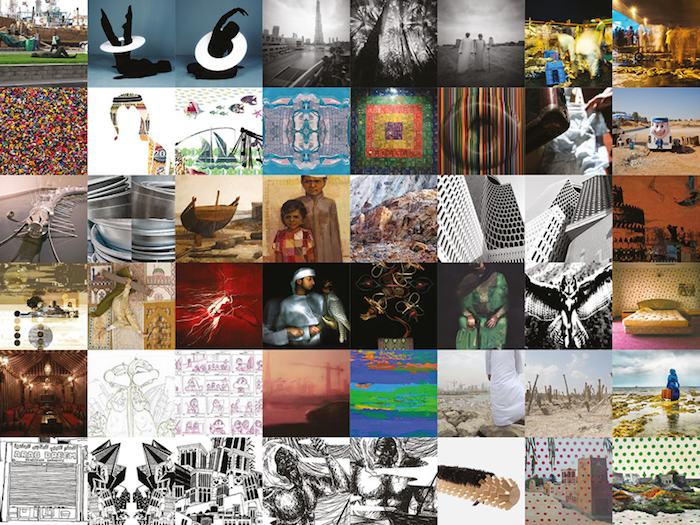
Past Forward: Contemporary Art from the Emirates is a new exhibition taking place at Meridian International Center in Washington, DC from 22nd May till 13th July 2014. It features over 50 paintings, photographs, sculptures, video installations and other media by artists from the United Arab Emirates.
The exhibition is a partnership between Meridian International Center and the UAE Embassy, curated by Dr. Curtis Sandberg, Vice President for Arts and Cultural Programs at the Meridian International Center and Noor Al Suwaidi, an Emirati artist and curator from Abu Dhabi.
The exhibition will travel across the United States over the next 18 months, including stops in Texas, California and Washington. This is the first major touring exhibition featuring Emirati artists. It's aim is to "showcase the creativity radiating throughout the Emirati art scene and highlight the development and history of the United Arab Emirates".
The overarching theme of the exhibition highlights the balance between the UAE’s rapid development while maintaining its ties to its heritage and past and honoring traditional values. The exhibition features core elements of Emirati life and represents all seven emirates while emphasizing the importance of kinship and home, nature and landscape, as well as technology and innovation to Emirati culture.
Meridian International Center has partnered with the UAE Embassy to share the UAE’s compelling narrative and rich cultural heritage through this groundbreaking cultural diplomacy art initiative, which will be a powerful tool for finding common ground, building lasting relationships, and fostering respect.
Past Forward will provide an opportunity for peer-to-peer exchanges of ideas, information, and experiential learning, as well as a framework for Americans and Emiratis to better understand one another through first-hand insight into life and culture in the UAE through these works of art.
The exhibition includes the following 25 Emirati artists*:
Abdul Qader Al Rais, Afra Bin Dhaher, Alaa Edris, Alia Lootah, Alia Saeed Al Shamsi, Ammar Al Attar, Ebtisam Abdulaziz, Farah Al Qasimi, Hamdan Buti Al Shamsi, Khalid Al Banna, Khalid Mezaina, Khalid Shafar, Lamya Gargash, Lateefa Bint Maktoum, Maitha Al Mehairbi, Maitha Bin Demaithan, Mattar Bin Lahej, Mohammed Al Qassab, Mohammed Saeed Harib, Najat Makki, Obaid Suroor, Salama Nasib, Shaikha Al Mazrou, Shamma Al Amri, Zeinab Al Hashemi
There is an educational aspect to this "cultural diplomacy initiative" and I am looking forward to the public's response to this exhibition and the reviews it gets.
Here's a small selection of work that can be seen at the exhibition (and if you cannot visit, you can see work by all the artists here).
Abdul Qader Al Rais
Abdul Qader Al Rais Al Jalbout (Pearl Diving Boat), 1987 | Oil on canvas | t 30ʺ x 42.5ʺ
One of the UAE’s most critically acclaimed artists, Abdul Qader Al Rais uses a photorealistic style to paint landscapes and architectural scenes inspired by traditional Emirati neighborhoods, buildings, and forts. He also creates nonrepresentational paintings that incorporate abstracted calligraphy and his signature motif, floating squares.
In the mid-1980s, Al Rais sojourned in the United States and was so inspired by American landscapes that he began painting his homeland with renewed vigor. One of his more recent watercolors, Thekrayat, which means “memories” in Arabic, refers to the artist’s recollections of the importance of the land to Emiratis. The painting depicts the rural outskirts of Fujairah, the only emirate without a coastline along the Arabian Gulf.
Afra Bin Dhaher
Afra Bin Dhaher Prayer Rugs, Self-Portrait series, 2011 | Photograph | 25.75ʺ x 23.5ʺ
Afra Bin Dhaher’s creative practice involves informing viewers, translating experiences, and portraying emotions. She seeks to generate discourse by exploring gender identity in Emirati society.
For her Self-Portrait series, Bin Dhaher, surrounded by various household belongings, contorts her body into carefully composed positions, which reference classical Middle Eastern artistic conventions. According to the artist, these constructed domestic scenes depict intimate memories, as she rediscovers everyday objects and reminisces about her past in the United Arab Emirates.
In Prayer Rugs, Bin Dhaher poses against a background of prayer rugs, while she grasps one in her hands. This work expresses her connection to religion and how she carries its values with her wherever she goes.
Alaa Edris
In Kharareef – Fables from the Trucial States, Alaa Edris appropriates found film footage and melds it with her own work to create a visual version of the Emirates’ oral traditions. The video adopts an expressionist cinematic style with its assembled recordings, which form a dreamlike path for viewers.
It is composed of excerpts from British documentaries that tell the story of the Emirates before their confederation along with footage from the artist’s personal video archive. “Kharareef” refers to fables that elderly family members recounted to impart moral lessons to children. The heroes of these stories are seven women who allude to jinnat, female demons that served as popular subjects in Arab folklore.
Alia Saeed Al Shamsi
Left: Alia Saeed Al Shamsi, Forgotten Building I (Burj Dubai), 2010 | Photograph | 30ʺ x 20ʺ
Right: Alia Saeed Al Shamsi, Forgotten Building II (Burj Dubai), 2010 | Photograph | 30ʺ x 20ʺ
The concept behind Alia Saeed Al Shamsi’s Forgotten Building series is to showcase the urban development in the United Arab Emirates that occurred from the 1960s to the 1980s. The artist avoids Dubai’s iconic skyscrapers and instead chronicles earlier, rarely discussed architecture to underscore the importance of historic preservation.
In Forgotten Building I, she photographs structures primarily built during the 1980s in Deira, a business district in Dubai that has lost some of its significance in recent years due to new commercial developments throughout the country. Since these older structures are often overlooked or forgotten, Al Shamsi highlights their unique characteristics using dynamic perspectives and compositions to evoke a renewed sense of pride for these architectural gems.
Hamdan Buti Al Shamsi
Hamdan Buti Al Shamsi Harmony, 2014 | Mixed media | 22.5ʺ x 32ʺ
Hamdan Buti Al Shamsi combines vintage photographs and newspaper clippings with abstract geometric forms inspired by modern architecture for his digital works. For Harmony, he employs a technique known as photo transfer to manipulate images of his ancestral home, Al Ain, the second largest city in the emirate of Abu Dhabi. Al Ain, which means “the spring,” was once an oasis that served as a vital water source for travelers following a caravan route from Oman to the territory of the UAE.
Harmony features the city’s prominent landmarks, such as the Al Jahili Fort – a structure erected in the late nineteenth century to defend Al Ain and its prized palm groves. The artist also alludes to the popular Emirati pastime, falconry, with the inclusion of the bird on the right.
Khalid Mezaina
Khalid Mezaina Arab Dreem, 2013 | Serigraph | 6.75ʺ x 15.5ʺ
Khalid Mezaina’s works represent the influence of popular culture, such as comic books, music, fashion, and art, on his personal life and professional practice. In his artistic approach, the artist gravitates primarily to hand-drawn illustrations on paper. His designs emerge from a particular mood to communicate social messages – or for pure amusement.
Mezaina also expresses Emirati culture in a hip or pop-art manner. Drawing on inspirations from everyday life, his illustrations allow his audience to embrace the beauty of Arabic traditions while living in a complex, modern world.
Khalid Shafar
Khalid Shafar Fallen Palm (bench), 2012 | Ash, walnut, metal, and goat hair | 17.25ʺ x 72.5ʺ x 15.75ʺ
Khalid Shafar recalled his fond memories of the desert landscape and its flora to create a sleek, innovative design line that echoes the aesthetic of the palm tree. Fallen Palm, a unique bench, represents palm trunks that have fallen as a result of advanced years or damage from storms. The bench features a cushion upholstered with goat hair and drawers concealed in each end for storing small objects.
Shafar thoughtfully included spaces between the wooden fronds for magazines to be displayed. Date palms historically played a significant role in Bedouin life. Their trunks supported the roofs of mudbrick towers; their dried leaves formed wall partitions and provided shade; and their fibers were used to make ropes, baskets, and mats.
Lateefa bint Maktoum
Lateefa bint Maktoum Observers of Change I, 2011 | Photograph | 58.25ʺ x 86.5ʺ
Lateefa bint Maktoum combines many of her images to create digital photomontages depicting ethereal scenes that examine transformations in the UAE’s landscape and culture. Using her personal experiences from living in Dubai, bint Maktoum portrays faceless observers of change to convey Emiratis’ ability to embrace the future while maintaining their identity and remembering the past.
Maitha Demithan
Maitha Demithan Ajyal (Generations), 2012 | Scanograph | 54.25ʺ x 64.5ʺ
Maitha Demithan employs a technique in her digital works known as scanography. She uses a small flatbed scanner to take multiple images of her subjects and digitally enhances them to create ethereal portraits. The artist’s immediate family and close friends regularly serve as her subjects, who often appear floating on black backgrounds.
During the creation process, Demithan enriches the colors and accentuates different textures, especially fabrics. Her works express the value of family and clan traditions while also alluding to the past. Ajyal documents conventional dress together with falconry, where training practices are passed down from male family members to young men. In this artwork, the falcon symbolizes the Emirates, whereas the quail, its food source, is a metaphor for elders feeding their heritage to future generations.
Mohammed Al Qassab
Mohammed Al Qassab Aluminum Life series, 2010 | Aluminum containers | 15.75ʺ x 25.5ʺ x 135.75ʺ
Mohammed Al Qassab creates mixed media works that integrate ordinary objects from everyday life, calling attention to these often unnoticed materials. In his Aluminum Life series, composed of a sculpture and photographs, the artist alludes to the UAE’s large aluminum industry.
Currently, the country is the world’s fifth largest exporter of this malleable metal. The series showcases products, such as cooking utensils and materials used in the nation’s construction boom, rendering them unrecognizable. For the sculpture, the artist forged the biomorphic form from recycled aluminum canisters that traditionally have served as milk containers.
Al Qassab envisions Aluminum Life as a reminder to the younger generation about Emirati heritage and the importance of aluminum for their country.
Salama Nasib
Salama Nasib Bu Daryah, 2014 | Screenprint on paper | 11.25ʺ x 4.5ʺ each (4)
In her works, Salama Nasib creates narratives using a metaphorical and surreal approach that capture viewers’ attention and makes them question what they perceive. In Bu Daryah, she depicts one of the many popular myths historically told as bedtime stories to children in the Emirates. These fables combine reality with the narrator’s imagination to convey specific messages.
“Bu Daryah” is one of the famous legends of the sea, where the eponymous figure, a jinni, or supernatural being, haunts the Gulf waters and appears at midnight to abduct sailors and burn their boats. Because of this legend, pearling ships often placed men on guard duty at night to protect their crews from harm.
Zeinab Al Hashemi
Zeinab Al Hashemi Pearl Tale, 2010 | Scanograph | 17ʺ x 24ʺ
Zeinab Al Hashemi’s work ranges from installation to video, and her process heavily depends on personal encounters and the environment. She creates visual narratives using innovative techniques to pursue culturally relevant themes.
In Pearl Tale, the artist explores the historic significance of maritime culture in the United Arab Emirates through depictions of sea life, fishermen, and a dhow – an Arab sailing vessel with one or two masts. With an eye for design, Al Hashemi prefers to transform an already existing object into new forms.
For this work, she appropriates scanned UAE currency to tell the story of pearl diving. Historically, people living on the coast relied on the pearl trade due to a lack of arable soil and scarcity of freshwater sources onshore.
Event details
Dates: 22nd May to 13th July 2014, Wednesday-Sunday from 2.00pm-5.00pm
Venue: Meridian International Center, Cafritz Galleries, White-Meyer House, 1624 Crescent Place, NW, Washington, DC 20009 (location map)
Contact: TKHarvey@meridian.org (Terry Harvey, Director of Exhibitions)
*Disclosure: My brother, Khalid Mezaina is one of the artists taking part in this exhibition.

